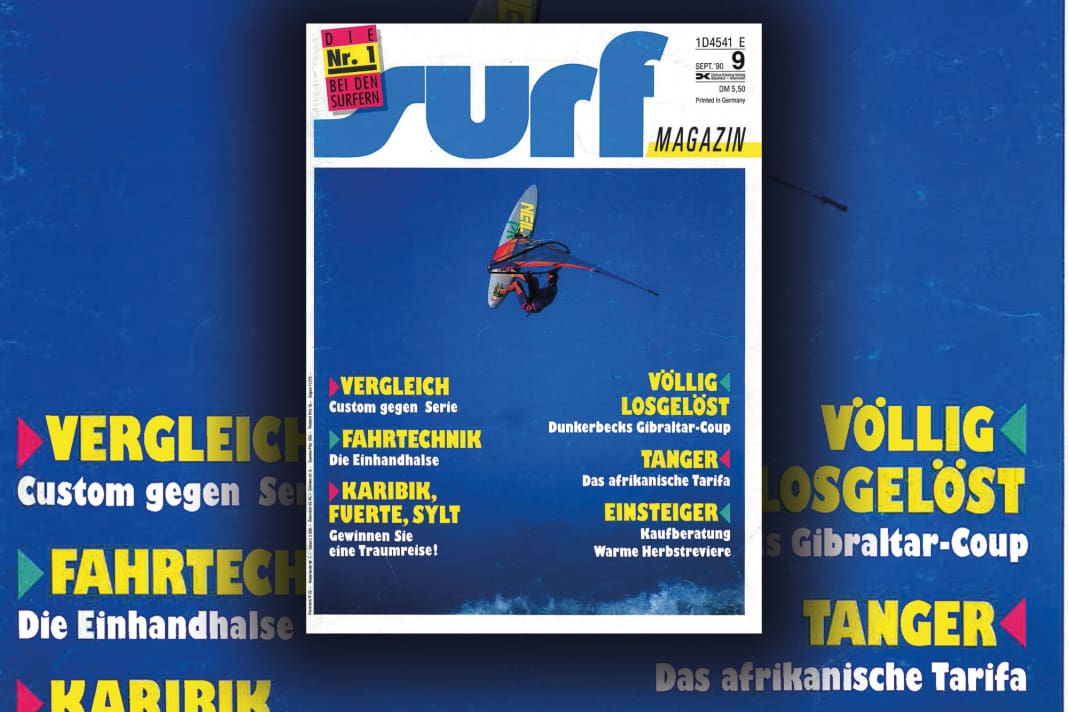





You can click through the entire magazine in the gallery above!
Series boards vs. custom mades
The surf test team investigates the eternal question: Are customised mades better than standard boards? While the industry used to cater to the large target groups and fans of small wave boards looked to the custom manufacturers, the brands are constantly bringing new, increasingly radical boards onto the market. "This is where image is made", is the realisation - and with 3000-5000 boards, there is a lot to be gained in the custom market. surf pits selected custom boards against mass-produced goods in several areas of application: Radical Wave, Euro Wave and Slalom. The judgements come from the freak, tie-wearer and yuppieh respectively. The eye-catchers are the Surf Line Sylt boat with its shiny black underwater hull, which turns into a frying pan in the sun, and the F2 Revolution from the quite rightly suppressed era of political designs. On the Horney slalom board, the pilot is accompanied by the "piercing gaze of a bald-headed head teacher", while the rest is more or less in keeping with the taste of the late eighties and early nineties. Apropos: "Only with the help of the Radical Decree can individual test riders be separated from this wave slasher" is something that hardly anyone understands today.
A look behind the scenes of surfboard construction
Back in 1990, the manufacture of surfboards was a highly industrialised affair. "There's nothing left of the paste-up orgies of the windglider era," marvelled surf author Andreas Erbe during a visit to the Fanatic factory. Around 35,000 boards are built there every year, and as part of the Schütz Group, the windsurfing division can draw on many synergy effects. The prototype is measured using CAD ("300 megabytes of information!"), a milling machine carves the negative mould in which the foam core is then created and later clothed "like an ancient Egyptian nobleman". Finally, everything is wrapped in ASA skin in a large mould. All plastic parts are also injection moulded in aluminium moulds in the factory. However, with decreasing quantities and rising wages, this industrial production did not remain lucrative for long: nowadays, surfboards are once again built by hand and almost exclusively in the Far East, as surf editor Manuel Vogel was recently able to experience during a visit to the Cobra factory: The dream factory - a look behind the scenes at board manufacturer Cobra
The legendary Bay of Pigs
Many years before the last visit 2006 surf mingled with the surfers at the legendary Bay of Pigs on Lake Garda. Exactly at kilometre 108 of the Gardesana occidentale, the most coveted parking spaces in the country are right next to the road. If you park here, you won't give up your spot for the world - despite the infernal traffic noise and absolutely no space around the car. Why? Because the Vento wind blows particularly strongly here, because the best surfers on Lake Garda can be found here. "Anyone arriving here with a board bigger than 250 will be smiled at," says a local. If you don't sleep in your car, but in a sleeping bag on the barren and tiny stone beach, you have to be careful not to be blown into the water in the morning. Accidents happen again and again, "Full braking is the order of the day, after all, the board and rig have to get over the road wall into the water somehow." Officially, camping is even forbidden, and the carabinieri are busy towing people away. The inhospitable area and the hardened Bay of Pigs locals have fuelled the myth over the years - but now there is a total parking ban.
And what else?
- Mike Eskimo designs a special sail to draw attention to the danger to whales from large-scale hunting and loops it as a "hot shot" in the magazine
- Björn Dunkerbeck wins the race across the Strait of Gibraltar with a new record time of around 44 minutes. With him: Pascal Maka and a few sharks
- The "Surf Trade Association" wants to throw out all retailers who are represented at boot in order to prevent "ruinous competition".
- Movement in the industry: NeilPryde has taken over Tiga and wants to win over the "young savages" with "seven boards under three metres". Fanatic has taken over the rights and machines from Alpha and wants to position the bankrupt brand in the budget segment.
- The best spots on the East German Baltic coast were presented shortly after the tack. However, the numerous inland waters in the new federal states still have to wait: the water quality is simply too poor in many places.
- In addition to the sails, direct mail order company GunSails also has a "Gun-Bike" on offer.
- At the Funboard Cup off Sylt, Bernd Flessner wins with a "world-class" performance ahead of local Edsard Eicker - who recently took part in the World Cup 2025 as a wild card.
You can click through the entire magazine in the gallery above!

